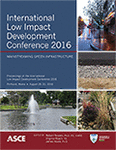International Low Impact Development Conference 2016
Examination of Empirical Evidence and Refining Maintenance Techniques for GI
Publication: International Low Impact Development Conference 2016: Mainstreaming Green Infrastructure
ABSTRACT
The use of green infrastructure (GI) to mitigate the effects of increasing rate of urbanization has not been without challenges. Determining the clogging patterns and finding the issues with clogging will enable the researchers to address some of these challenges. Two GI stormwater control measures (SCMs) were constructed in Louisville, KY, utilizing permeable pavers in December 2011. Using empirical methods for maintenance, one paver strip has been maintained quarterly and the other only when requested. Using sweeper truck as the first method and air pressure tools as the second method, the clogging material was recovered and analyzed for particle size distribution and organic content. Characteristics of clogging material are used to provide refinement to the maintenance method, frequency for remedial methods. By dividing each SCM into equal small segments, the material collected using the air pressure maintenance provides a better description of the behavior of the SCM. With the more frequent maintenance, fines are mostly trapped up gradient and larger particles with majority of organics are trapped down gradient. The shorter SCM with more service time has shown that the penetration of fines is almost equal all segments. Finally, the quarterly maintenance plan is found more suitable than the other.
Get full access to this article
View all available purchase options and get full access to this chapter.
REFERENCES
AGF (2000). Drainage Factsheet: Drain Filters and Envelopes. British Columbia, Ministtry of Agriculture and Food.
ASTM (2007). Standard Practices for Preserving and Transporting Soil Samples. D 4220 - 95. West Conshohocken, PA, ASTM International.
ASTM (2007). Standard Test Methods for Moisture, Ash, and Organic Matter of Peat and Other Organic Soils. D 2974 – 07a. West Conshohocken, PA, ASTM International.
Bean, E., W. Hunt, et al. (2007). “Field Survey of Permeable Pavement Surface Infiltration Rates.” Journal of Irrigation and Drainage Engineering 133(3): 249-255.
Borst, M., A. A. Rowe, et al. (2010). Surface Infiltration Rates of Permeable Surfaces: Six Month Update (November 2009 through April 2010). EPA/600/R-10/083, Office of Research and Development.
Brattebo, B. O. and and D. B. Booth (2003). "Long-term stormwater quantity and quality performance of permeable pavement systems." Water Research 37(18): 4369-4376.
Brown, R. and and M. Borst (2013). "Assessment of Clogging Dynamics in Permeable Pavement Systems with Time Domain Reflectometers (TDRs)." Journal of Environmental Engineering.
Gerrits, C. and and W. James (2002). Restoration of infiltration capacity of permeable pavers. 9th International Conference on Urban Drainage, Portland, Oregon.
González-Angullo, N., D. Castro, et al. (2008). "Runoff infiltration to permeable paving in clogged conditions." Urban Water Journal5(2): 117-124.
Hamilton, R. S., D. M. Revitt, et al. (1984). "Levels and physico-chemical associations of Cd, Cu, Pb and Zn in road sediments." Science of The Total Environment 33(1–4): 59-74.
Haselbach, L. M., S. Valavala, et al. (2006). "Permeability predictions for sand-clogged Portland cement pervious concrete pavement systems." Journal of Environmental Management 81(1): 42-49.
Hvitved-Jacobsen, T. (1982). "The impact of combined sewer overflows on the dissolved oxygen concentration of a river." Water Research 16(7): 1099-1105.
Jaffe, M., M. Zellner, et al. (2010). A Review of Selected Practices and State Programs, A draft report to The Illinois Environmental Protection Agency, University of Illinois at Chicago, Chicago Metropolitan Agency for Planning, Center for Neighborhood Technology, University of Illinois at Urbana-Champaign.
Mata, L. A. (2008). Sedimentation of pervious concrete pavement systems, North Carolina State University.
Pratt, C. J., J. D. G. Mantle, et al. (1995). "UK research into the performance of permeable pavement, reservoir structures in controlling stormwater discharge quantity and quality." Water Science and Technology 32(1): 63-69.
Sarte, S. B. (2010). Sustainable Infrastructure: The Guide to Green Engineering and Design, Wiley.
Shuster, W. D., J. Bonta, et al. (2005). "Impacts of impervious surface on watershed hydrology: A review." Urban Water Journal 2(4): 263-275.
Smith, D. R. (2011). Permeable Interlocking Concrete Pavements, Interlocking Concrete Pavement Institute (ICPI).
Viklander (1998). "Particle Size Distribution and Metal Content in Street Sediments." Journal of Environmental Engineering 124(8): 761-766.
Welker, A., J. Jenkins, et al. (2012). "Examination of the Material Found in the Pore Spaces of Two Permeable Pavements." Journal of Irrigation and Drainage Engineering.
Information & Authors
Information
Published In
International Low Impact Development Conference 2016: Mainstreaming Green Infrastructure
Pages: 65 - 77
Editors: Robert Roseen, Ph.D., Waterstone Engineering, Virginia Roach, CDM Smith, and James Houle, Ph.D., The University of New Hampshire
ISBN (Online): 978-0-7844-8054-0
Copyright
© 2017 American Society of Civil Engineers.
History
Published online: Oct 11, 2017
Authors
Metrics & Citations
Metrics
Citations
Download citation
If you have the appropriate software installed, you can download article citation data to the citation manager of your choice. Simply select your manager software from the list below and click Download.
